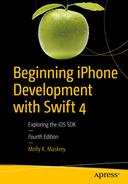Molly K. Maskrey
Beginning iPhone Development with Swift 4
Exploring the iOS SDK
4th ed.

Molly K. Maskrey
Parker, Colorado, USA
Any source code or other supplementary materials referenced by the author in this text is available to readers at www.apress.com . For detailed information about how to locate your book’s source code, go to www.apress.com/source-code/ .
ISBN 978-1-4842-3071-8
e-ISBN 978-1-4842-3072-5
https://doi.org/10.1007/978-1-4842-3072-5
Library of Congress Control Number: 2017957132
© Molly K. Maskrey 2017
This work is subject to copyright. All rights are reserved by the Publisher, whether the whole or part of the material is concerned, specifically the rights of translation, reprinting, reuse of illustrations, recitation, broadcasting, reproduction on microfilms or in any other physical way, and transmission or information storage and retrieval, electronic adaptation, computer software, or by similar or dissimilar methodology now known or hereafter developed.
Trademarked names, logos, and images may appear in this book. Rather than use a trademark symbol with every occurrence of a trademarked name, logo, or image we use the names, logos, and images only in an editorial fashion and to the benefit of the trademark owner, with no intention of infringement of the trademark. The use in this publication of trade names, trademarks, service marks, and similar terms, even if they are not identified as such, is not to be taken as an expression of opinion as to whether or not they are subject to proprietary rights.
While the advice and information in this book are believed to be true and accurate at the date of publication, neither the authors nor the editors nor the publisher can accept any legal responsibility for any errors or omissions that may be made. The publisher makes no warranty, express or implied, with respect to the material contained herein.
Printed on acid-free paper
Another year, another revision of this book, as well as one of my own personal tribe.
Still around after more than two years of ups and downs, KP stuck beside me during my most difficult times. No matter what I did, her sanity and silliness kept me going. She was, for a long while, my muse…my inspiration to write and to keep it as fun as possible…never taking myself too seriously. Now, as our paths slightly diverge, the qualities she’s left permeate my days and make me a better self.
Mellie has been my rock. We’ve been in and out of being friends, and I hope she knows I consider her the closest friend I’ve ever had. I probably wouldn’t be doing this if it weren’t for the love she’s shown me.
Tonya came into my life recently and has been such a godsend to help me become more confident in all I say and do, and I can’t thank her enough.
She probably has no clue she’s in here, but Lauren kept me going for the past year. When I would’ve preferred to lay in the dark and sleep and zone out, without any aggressiveness Lauren would give me something in her words to keep to going…to not give up. She—I won’t say forced, but she was very persuasive—got me into a program that is, this very day, putting me onto a better path for myself and my future and the future of anyone alongside me for my journey.
Finally, to Jennifer…our lives have radically changed over the past year. But, as partners in business and advocates for each other’s happy life, our relationship bond, while admittedly very tumultuous, has solidified into something we both see as pretty damn good.
In my personal struggles over the preceding year, these friends kept me from falling into an abyss so deep I might never have returned. Writing can be a lonely thing, and having a support system such as these beautiful, wonderful women are the only reason this endeavor was a success. A special friend told me last year that some friends are only in your life for a season. I pray that these women are friends for a lifetime.
—MM, August 2017
Acknowledgments
First, I want to acknowledge all my friends who gave me the support to persevere and go through with writing when it would have been so easy to just give up. Thanks to Sam especially, another writer I met more than a year ago, who was always there to provide support, drink tequila, and suggest fun things to do in order to keep it real. He was my cohost at almost a year of rooftop parties at Galvanize.
Thanks to Children’s Hospital Colorado and the Center for Gait and Movement Analysis, both of which have been so generous to let me be part of what they do for young adults with cerebral palsy and other gait disorders. The understanding I’ve gained drives me to focus my efforts on helping the many who truly need it. Thanks to the CEOs of 10.10.10 Health who let me see what they were doing and to provide my annoying feedback.
Thanks to the clients and friends of Global Tek Labs who so generously allowed me to include some of their projects in this book for illustrative purposes. Thanks to the hundreds of people who have attended my talks over the past year and have given me ideas for what to include, such as John Haley who told me of his personal woes in understanding the Auto Layout feature of Xcode. Those actual experiences helped drive the subject matter I chose to include in this book.
Finally, I want to acknowledge all the authors before me who set the stage for my own little work to fit into a much broader landscape.
Contents
- Chapter 1: Getting to Know the iOS Landscape
- Chapter 2: Writing Your First App
- Chapter 3: Basic User Interactions
-
Chapter 4: Adding Intermediate-Level User Interactions
- Understanding Active, Static, and Passive Controls
- Creating the ControlFun Application
-
Implementing the Image View and Text Fields
- Adding the Image View
- Resizing the Image View
- Setting View Attributes
- Using the Mode Attribute
- Using the Semantic Attribute
- Using Tag
- Using Interaction Check Boxes
- Using the Alpha Value
- Using Background
- Using Tint
- Drawing Check Boxes
- Stretching
- Adding the Text Fields
- Using Text Field Inspector Settings
- Setting the Attributes for the Second Text Field
- Adding Constraints
- Creating and Connecting Outlets
- Closing the Keyboard
- Closing the Keyboard When Done Is Tapped
- Touching the Background to Close the Keyboard
- Adding the Slider and Label
- Creating and Connecting the Actions and Outlets
- Implementing the Action Method
- Implementing the Switches, Button, and Segmented Control
- Adding Two Labeled Switches
- Connecting and Creating Outlets and Actions
- Implementing the Switch Actions
- Adding the Button
- Adding an Image to the Button
- Using Stretchable Images
- Using Control States
- Connecting and Creating the Button Outlets and Actions
- Implementing the Segmented Control Action
- Implementing the Action Sheet and Alert
- Displaying an Action Sheet
- Presenting an Alert
- Summary
- Chapter 5: Working with Device Rotations
- Chapter 6: Creating a Multiview Application
- Chapter 7: Using Tab Bars and Pickers
- Chapter 8: Introducing Table Views
-
Chapter 9: Adding Navigation Controllers to Table Views
- Understanding Navigation Controller Basics
- Fonts: Creating a Simple Font Browser
-
Creating the Font Sizes View Controller
- Creating the Font Sizes View Controller Storyboard
- Implementing the Font Sizes View Controller Prepare for Segue
- Creating the Font Info View Controller
- Creating the Font Info View Controller Storyboard
- Adapting the Font List View Controller for Multiple Segues
- Creating My Favorite Fonts
- Adding Features
- Implementing Swipe-to-Delete
- Implementing Drag-to-Reorder
- Summary
- Chapter 10: Collection Views
- Chapter 11: Split Views and Popovers for iPad Apps
- Chapter 12: App Customization with Settings and Defaults
- Chapter 13: Persistence: Saving Data Between App Launches
- Chapter 14: Graphics and Drawing
- Appendix A: An Introduction to Swift
- Swift Basics
- Playgrounds, Comments, Variables, and Constants
- Predefined Types, Operators, and Control Statements
- Arrays, Ranges, and Dictionaries
- Optionals
- Control Statements
- Functions and Closures
- Error Handling
- Classes and Structures
- Structures
- Classes
- Properties
- Methods
- Optional Chaining
- Subclassing and Inheritance
- Protocols
- Extensions
- Summary
- Index
Contents at a Glance
- About the Author
- About the Technical Reviewer
- Acknowledgments
- Chapter 1: Getting to Know the iOS Landscape
- Chapter 2: Writing Your First App
- Chapter 3: Basic User Interactions
- Chapter 4: Adding Intermediate-Level User Interactions
- Chapter 5: Working with Device Rotations
- Chapter 6: Creating a Multiview Application
- Chapter 7: Using Tab Bars and Pickers
- Chapter 8: Introducing Table Views
- Chapter 9: Adding Navigation Controllers to Table Views
- Chapter 10: Collection Views
- Chapter 11: Split Views and Popovers for iPad Apps
- Chapter 12: App Customization with Settings and Defaults
- Chapter 13: Persistence: Saving Data Between App Launches
- Chapter 14: Graphics and Drawing
- Appendix A: An Introduction to Swift
- Index
About the Author and About the Technical Reviewer
About the Author

Molly K. Maskrey started as an electrical engineer in her 20s working for various large aerospace companies including IBM Federal Systems, TRW (now Northrup-Grumman), Loral Systems, Lockheed-Martin, and Boeing. After successfully navigating the first dot-com boom, she realized that a break was in order and took several years off, moving to Maui and teaching windsurfing at the beautiful Kanaha Beach Park.
She moved back to Colorado in 2005 and, with Jennifer, formed Global Tek Labs, an iOS development and accessory design services company that is now one of the leading consulting services for new designers looking to create smart attachments to Apple devices.
In 2014 Molly and Jennifer formed Quantitative Bioanalytics Laboratories, a wholly owned subsidiary of Global Tek to bring high-resolution mobile sensor technology to physical therapy, elder balance and fall prevention, sports performance quantification, and instrumented gait analysis (IGA). In a pivot, Molly changed the direction of QB Labs to a platform-based predictive analytics company seeking to democratize data science for smaller companies.
Molly’s background includes advanced degrees in electrical engineering, applied mathematics, data science, and business development. Molly generally speaks at a large number of conferences throughout the year including the Open Data Science Conference (ODSC) 2017 West, advancing the topic of moving analytics from the cloud to the fog for smart city initiatives. What fuels her to succeed is the opportunity to bring justice and equality to everyone whether it’s addressing food insecurity with her business partner or looking at options for better management of mental health using empirical data and tools such as natural language processing, speech pattern recognition using neural networks, or perfusion analysis in brain physiology.
About the Technical Reviewer
Bruce Wade is a software engineer from British Columbia, Canada. He started software development when he was 16 years old by coding his first web site. He went on to study computer information systems at DeVry Institute of Technology in Calgary; to further enhance his skills, he studied visual and game programming at the Art Institute of Vancouver. Over the years he has worked for large corporations as well as several startups. His software experience has led him to utilize many different technologies including C/C++, Python, Objective-C, Swift, Postgres, and JavaScript. In 2012 he started the company Warply Designed to focus on mobile 2D/3D and OS X development. Aside from hacking out new ideas, he enjoys spending time hiking with his Boxer Rasco, working out, and exploring new adventures.
